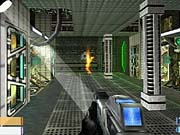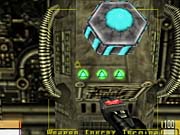Star Trek: Voyager Elite Force Updated Preview
We take a look at the PS2 port of this popular PC FPS.
The PlayStation 2 has received its fair share of first-person shooters, from original PS2 games like TimeSplitters to ports of PC products like Quake III Revolution. For its part, Majesco chose to go the port route with Star Trek: Voyager Elite Force. The company has picked one of the more acclaimed PC first-person shooters to convert to the PlayStation 2. Recently, we had the opportunity to log extensive playtime with the PlayStation 2 build of the game to bring you our updated impressions.

The game's story, cutscenes, and overall presentation remain virtually the same as those of the PC version. Voyager Elite Force begins with all the essential trappings of the TV show, as credits and the series' theme music roll over panoramic views of the Voyager, floating through nebulas and other extraterrestrial locations. The crew of the Voyager is continuing its journey from the Delta Quadrant to Earth, when it unexpectedly encounters a mysterious alien vessel. A spirited battle, which is shown partly in impressive prerendered FMV, ensues. Using the powerful photon torpedoes, the Voyager is able to destroy the alien ship, but a resultant shock wave from the explosion suddenly draws the vessel into a mysterious part of the universe--a ship graveyard of sorts. This is where the game begins. As ensign Munroe on the ship's hazard team, you must initially aid the ship's officers in repairing the damages sustained by the Voyager and eventually uncover the mysteries behind the sudden and unexplained teleportation of the starship.
The game keeps its roots--particularly in the presentation department--closely tied to the TV show. All the familiar characters from the series, including Captain Janeway and Seven of Nine, make appearances throughout the game. Most of the series' stars have been recruited to provide the voice talent in the game. So, for example, Janeway is voiced by Cate Mulgrew, and Chakotay is voiced by his TV counterpart, Robert Beltran. Additionally, you have access to rather extensive bios for each of the Voyager crewmembers. Interested in Tuvok's motivations in joining the Voyager crew? You can simply look it up on the game's crew listing. Even the game's menu is patterned after the Voyager computer interface from the TV show. All of this attention to detail adds up to quite an authentic experience, as the game effectively exudes the feeling of actually being involved in a lengthy episode of Star Trek: Voyager.

In terms of gameplay, the primary differences between the PC and the PlayStation 2 version lie naturally in the control system. The game's complex control options require that every single button on the PlayStation 2 controller be used. For example, as in games like TimeSplitters, the left analog stick on the PS2 dual-shock controller is used for movement, while the right analog stick is used to look around. Although the game does include USB mouse and keyboard support, the PlayStation 2 version compensates by using an auto-aim system when you're using a controller. The auto-aim is generally quite adequate, but at times, the lock-on feature seems to be too fidgety. Particularly, when a large group of enemy attackers filled the screen, we found ourselves battling with the right analog stick to get the crosshairs aimed on the right enemy character. You might have the closest enemy attacker locked on, but a slight movement of the right analog can prompt the auto-aim feature to lock onto a more distant enemy, which can eventually force you to take on unnecessary damage. As with most first-person shooters, the keyboard and mouse configuration is easily more effective. But hopefully, Pipe Dream Interactive, the game's developer, will address these auto-aiming and sensitivity issues before the game's final release.
A variety of other control options are mapped to the PlayStation 2 controller. You can jump and crouch with the L1 and L2 shoulder buttons, respectively. You can fire your weapons with the R1 and R2 buttons, but don't forget that you run out of ammo rather quickly and need to constantly replenish by searching out the weapons refill stations on each level. You can toggle running on and off with the square button, you can center your view with the triangle button, you can access information on mission objectives with the circle button, and you can perform a variety of actions--such as opening doors and operating control panels--with the X-button. Finally, left and right on the D-pad cycles through weapons, and up and down zooms in and out. The general control scheme, other than the touchy auto-aim feature, works quite well in concert with the pace of the gameplay.
Calling All Hazard Team Members
As mentioned, in Voyager Elite Force, you assume the role of a hazard team member. The hazard teams, which were established to aid with ship malfunctions and enemy attacks, are composed of the alpha and beta team. Each team has a variety of specialists, including demolitionists, medics, weapons experts, snipers, intelligence, and field technicians. Throughout the course of the game, each of these team members will play a crucial role, so it's important to protect team members in peril. Furthermore, the gameplay in Voyager Elite Force takes its cues from games like Half-Life. There are a variety of scripted events in the game, but there is also quite a bit of interaction. For example, in one of the early sequences, you are asked to turn on a force field to protect your crewmembers from an oncoming blast. You can choose to turn on the force field and save your comrades or sacrifice their lives to open up a shortcut. Interaction with other crewmembers and your individual decisions play a significant role. Still, although there are quite a few, these interactive moments don't fundamentally alter the game's story, as different paths lead to the same general objectives.

Voyager Elite Force includes 30 levels of play, which take place on the Voyager itself and on a variety of alien spaceships. These environments are quite varied in motif, as they are designed to reflect the cultures and technology of each of the races in the game. However, it is evident that, at this stage, the PlayStation 2 version's visuals don't quite match the crisp visuals of the original PC game. There are issues with aliasing, and throughout most of the game, textures--particularly on walls and hallways--blur in and out. Additionally, the frame rate has a hard time holding the 30fps range and can fluctuate quite a bit, especially when fighting in some of the game's more robust environments. Still, much like the PC version, the weapons effects in the game are probably one of its more impressive visual elements. There are a wide variety of weapons, ranging from the traditional phasers to more powerful alien weaponry. Each weapon has its own unique visual effect when fired. One of the earlier weapons, for example, slowly disintegrates the enemy, causing it to fragment into tiny blue particles and dissolve into the air.
The PlayStation 2 version of Voyager Elite Force shares its gameplay modes with the PC version. Aside from the mission-based single-player mode, the game includes 33 multiplayer maps. Taking place inside a holodeck, these maps range from locations such as beta stations and outdoor alien worlds to medieval castles and sleepy towns reminiscent of classic Westerns. A good number of customization options are also available in multiplayer. You can tweak the point limit, time limit, weapons, and falling damage. Options such as forced respawn, team play, and friendly fire can also be turned on and off. Unfortunately, the PlayStation 2 version does not include online support, but it does let up to four players compete simultaneously in the multiplayer maps.
Star Trek: Voyager Elite Force on the PlayStation 2 shares much of its options, features, and gameplay system with the PC version. Naturally, the control scheme has been tweaked to fit the PlayStation 2 controller, but those so inclined do have the option to use a USB mouse and keyboard in the game. At this stage, the game doesn't quite match the PC game in the visuals department, but a smoother frame rate and cleaner textures would go a long way in resolving that issue. Star Trek: Voyager Elite Force will ship later this month for the PlayStation 2.
Got a news tip or want to contact us directly? Email news@gamespot.com
Join the conversation